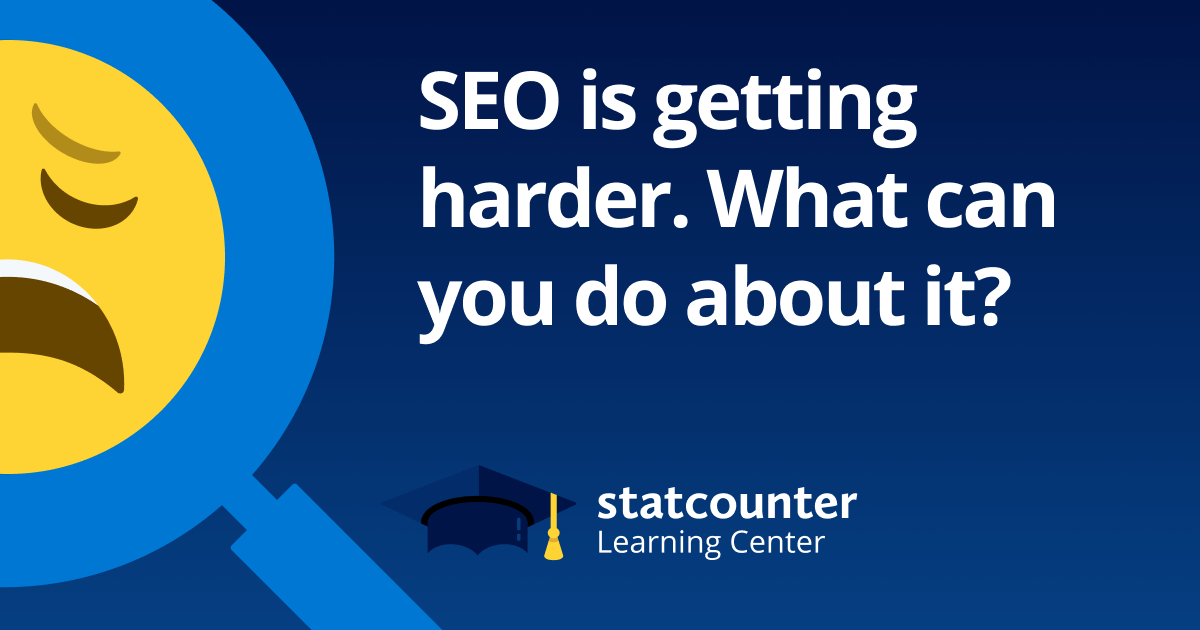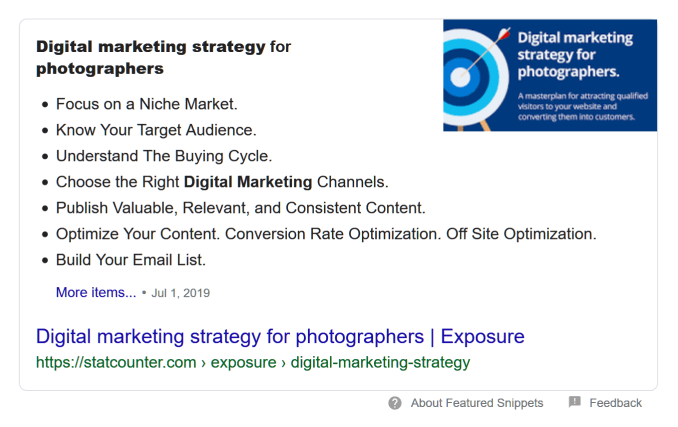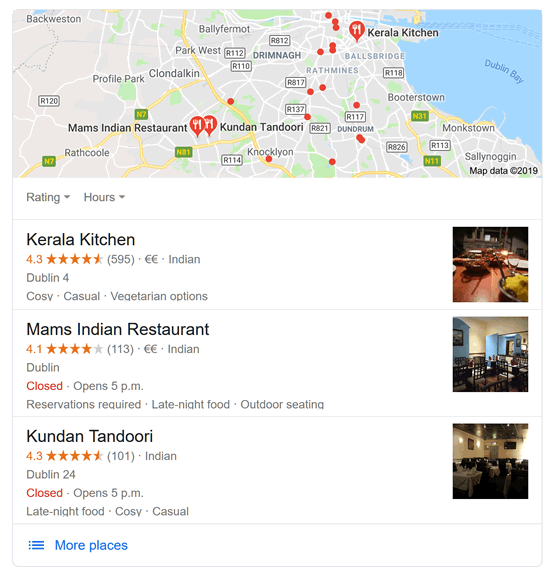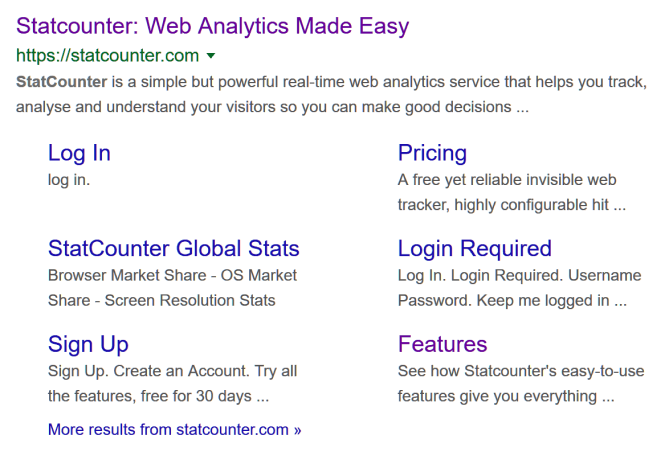
Engine
Optimization.


SEO is getting harder. What you can do about it?
How to find opportunities within SERP features to optimize and encourage clicks to your website.
- The rise of the advanced SERP feature
- I'm #1 so why try harder?
- Advanced Organic SERP Features
- SERP Feature Tracking Tools
- Conclusion
The rise of the advanced SERP feature.
Google's search engine results pages (aka SERPs) have changed dramatically over the past few years. Catering to the popularity of mobile and voice search and in an attempt to provide quick answers to user's search queries across all devices, Google have morphed from a search engine into an answer engine. They have recognised that their users would rather be presented with immediate answers than having to parse a page of links and jump back and forth between pages until their question has been answered.
This is all well and good for the Google user. However for website owners creating valuable content and optimizing our pages for organic search, not only do we have to contend with Google ads but a whole myriad of advanced SERP features are now competing for attention.
Advanced SERP features are distinct from traditional organic search results. In the example below, a desktop based search for artificial intelligence presents us with two columns.
In the left column, we a series of Google Ads, followed by a Featured Snippet, a Related Questions box, a Top Stories box, and only then do we see our first traditional organic search result (highlighted) more than halfway down the page, almost certainly below the fold on the majority of devices.
Further down we see the organic results are intercepted by a Videos box and competing for our attention in the right panel is a Knowledge Graph Card.

I'm #1 so why try harder?
As you can see in the image above, achieving the number one organic result in Google search simply isn't enough any more. There are so many more enticing things on the page to explore. Often, many of them will answer the search query without the user having to click.
Rand Fishkin, cofounder and CEO of SparkToro compiled data from Jumpshot into the chart below to show where users click after searching google.

The astonishing percentage of zero-click searches — 48.96% in Q1 2019 — can be attributed largely to Google's advanced SERP features answering user's search queries directly, without the need for a click.
For every click on a paid result in Google, there are 11.6 clicks to organic results. SEO is far from dead.— Rand Fishkin Cofounder and CEO of SparkToro
The good news is that 41.45% of Google searches — as represented in the blue segment in Rand's chart above — result in clicks to non-Google websites like yours and mine. And those clicks are coming from both traditional and advanced SERP features.
Hopefully we're all already practicing on-page optimization for traditional SERP features. Now we need to take advantage of every opportunity we can find within Google's advanced SERP features.
Advanced Organic SERP Features
To help you get started, we'll take a look at some of the most frequently occurring advanced SERP features in detail and show you how to structure and optimize your content to maximize your opportunities for clicks from Google search queries.
We'll be specifically focusing on advanced SERP features of the organic variety, so paid SERP features such as Google Ads and Google Shopping fall outside the scope of this guide.
Featured Snippet
What is a Featured Snippet?
Also known as 'position zero', Google's featured snippets take a snippet of content, in the majority of cases from one of the top ten organically ranking pages, and display it in a special format and above traditional organic search results.
Featured snippets come in a variety of different formats, including paragraph snippets, list snippets, table snippets and YouTube snippets.
 List Featured Snippet
List Featured Snippet
How to optimize for featured snippets?
- Format your content around questions.
- Use headings for your questions (e.g. H1, H2, H3).
- Provide succinct answers (40 - 50 words) directly below headings.
- Answer multiple related questions on the same page.
- Use paragraphs, lists, tables and videos to answer your questions.
 Table Featured Snippet
Table Featured Snippet
Knowledge Graph Card
What is the Knowledge Graph Card?
Google's Knowledge Graph Cards appear in the right hand column on desktop search results pages for certain types of queries and pull together information from a variety of sources. Some of the common queries that can result in a Knowledge Graph Card being displayed include:
- Local Businesses
- Nonprofit Organizations
- Companies
- Media
- Products
- Nutritional Information
- Influential People
 Local Business Knowledge Graph Card
Local Business Knowledge Graph Card
How to optimize for Knowledge Graph Cards?
- Add structured data markup to your site.
- If you're a local business, get set up on Google My Business.
- Ask your customers for Google reviews.
- Create a Wikipedia page for your business.
- Verify your social media accounts with Google.
Local Pack
What is the Local Pack?
The Local Pack, also known as the 'Google 3 Pack' or 'Google Snack Pack' is a SERP feature that displays in the #1 rank position 93% of the time for searches with local intent. It includes three local business listings and displays them on a Google Map.
Winning a prized position in the Local Pack depends on a number of factors. Google determines local ranking based on relevance, distance and prominence.
 Local Pack
Local Pack
How to optimize for Google Local Pack?
- Optimize your site for local search.
- Build authority through strong backlinks.
- Create a Google My Business account.
- Verify your address with Google.
- Ask your customers for Google reviews.
Top Stories
What are Top Stories?
The Top Stories carousel (previously the News Box feature) displays when news articles about current events match the users search query. If you're running a magazine or news publication, optimizing for the Top Stories feature can get you great visibility on SERPs for relevant searches.
 Google Top Stories Carousel
Google Top Stories Carousel
How to optimize for Top Stories?
- Utilize the Google AMP framework.
- Optimize your articles for Google News.
- Add structured data markup to your site.
- Optimize your page speed.
- Follow traditional SEO best practices.
Video Carousel
What is the Video Carousel?
Google's Video carousel displays videos relevant to a user's search query and includes a video thumbnail, video title, video channel title and date. 'How to' search queries often result in the Video Carousel appearing in position zero.
 Google Video Carousel
Google Video Carousel
How to optimize for the Video Carousel?
- Create videos that answer a 'How to' search query.
- Have a descriptive video title and description that include keywords.
- Obtain backlinks to your video from other sites.
If a video appears on a website page, it can also be optimised for SERPs with schema markup code.
Image Pack
What is the Google Image Pack?
When the Google algorithm considers images useful to a user's search query, the Image Pack display a series of images in carousel format, similar to the Video and Top Stories Carousels but without displaying any meta data.
 Google Image Pack
Google Image Pack
How to optimize for the Google Image Pack?
- Optimize your image sizes
- Use descriptive filenames that include keywords
- Use descriptive alt text that includes keywords
- Make sure the URL is human-readable
- Include a title attribute
People Also Ask
What is People Also Ask?
This SERP feature often displays below the featured snippet but can appear in different positions depending on what other SERP features are displaying. Displays a list of questions and answers related to the original search query. The questions are displayed in the form of an expandable list. Expanding any item reveals a featured snippet and also dynamically generates new related questions within the list.
 People Also Ask
People Also Ask
How to Optimize for People Also Ask?
Optimizing for the People Also Ask feature is much the same as for featured snippets:
- Format your content around questions.
- Use headings for your questions (e.g. H1, H2, H3).
- Provide succinct answers (40 - 50 words) directly below headings.
- Answer multiple related questions on the same page.
Site Links
What are Site Links?
The Site Links SERP feature displays a number of internal web page links (e.g. About Us, Contact Us) selected by Google's algorithm for brand and navigational search queries. The example below results from a search for 'statcounter'. Site links can increase CTR (click through rate) from SERPs. and also makes it easier for users to jump to an internal page on your site directly from the SERP.
 Site Links
Site Links
How to Optimize for Site Links?
- Include structured data markup on your site.
- Set pages you don't want to appear in site links as noindex.
- Make sure your site has a strong link and navigational structure.
Note: the Site Links feature displays more often for sites with high volume of branded search traffic.
SERP Feature Tracking Tools
There are a number of tools available that can help you find opportunities for SERP features and track how your are ranking for them for your target keywords.
- Moz — SERP Features
- Ahrefs — Rank Tracker
- SEMRush — Position Tracking
- Internet Marketing Ninjas — Featured Snippet Tool
To see how often advanced SERP Features occur across a generalized set of searches, see the SERP Feature Graph from Moz.
Track Your Organic Traffic wIth Statcounter
The Page Analysis feature in Statcounter helps you to track the traffic to your individual pages over time with a breakdown of Search Traffic, Website Referrals, Social and Paid traffic. The Search Traffic chart below the large Sessions chart shows all organic search traffic. Using Filters, you can choose to see only organic search traffic from Google.
 Page Analysis in Statcounter
Page Analysis in Statcounter
Conclusion
Searches resulting in zero clicks will continue to increase and the volume of organic traffic Google sends to our websites will continue to decrease. This makes SEO more important. To quote Rand Fishkin again, we must “leverage every scrap of traffic Google (and others) send us.” This means finding opportunities within organic results and SERP features to optimize and encourage clicks to our websites.

10 Comments
Thanks for the insight! I run a small family business and have noticed in the passed year my website hits have dropped massively and no changes or link changes have been made to it. Would you be able to recommend an on the ball website builder in the UK or elsewhere who could tweak my website to these new criteria mentioned in your article?
Thanks again! great work!
Henning
www.tacotruck.co.uk
Some more about him and contact links here:
https://statcounter.com/success-stories/mike-pead/
Content is NOT king, and when it is, it's being swamped by click-less advanced search results that keep the traffic trapped in the Google page while ripping off webmasters.
Hope people will start switching over to Bing and DuckDuckGo, they are not so nefarious, at least for now.
Don't bother trying to keep up with google's latest online marketing fads and trends. Like many if not most of google's service offerings, since the beginning, fads will either change dramatically or disappear entirely, and right when you least expect it.
Search results pages are starting to resemble facebook pages, and not in a good way.
I've had a presence online for 20? years, but never saw that I have a Knowledge Panel there before, so thanks for that. I did get pretty riled up, however when Google's instructions to update or fix it include verifying YOURSELF - and to do that they want a selfie with a government -issued ID! Who do they think they are, the police? KGB? Big Brother? And why would anyone give that info to any online business?? I wrote a letter to their legal dept complaining about that invasion of privacy and the fact that the Knowledge Panel itself is stolen intellectual property. (Can you tell that one of the issues I write about is privacy? :) )
# Google Cloud subnet blockieren
deny from 35.187
deny from 35.195
deny from 35.205
deny from 35.240
deny from 104.199
#Google Cloud einzelne IPs
deny from 35.187.160.194
deny from 35.187.186.254